Chapter
5 - Military Tradition and the New Militias
The
Tradition of Military Service
After 1850 many Coleraine volunteers
continued to serve the Crown during Britain’s conflicts. That
included the Crimean War in 1855. After the Crimean War a Russian
cannon was presented to the town in 1859 to mark the contribution
made by the Coleraine volunteers. Coleraine volunteers were also
well represented during the Zulu War in 1879, the Egypt War in
1882, the first Boer War 1881 and the second Boer War in
1899-1902.
One of the local veterans, William McSheffery, called the
Boer Wars the first and second African wars. He served in both
and was invalided out of the Inniskilling Fusiliers at the start
of WWI before going on to dig the trenches in France. He often
recalled how he had to cut his spade through the bodies of men
and horses so that the trench followed the plans they were
working to.
Robert Gamble also fought in South Africa and his South
Africa 1902 medal has the clasps for the Transvaal and the Orange
Free State. He also served during WWI in the Royal Inniskilling
Fusiliers. He was too old for military service when WWII started
but two of his sons, Tom and Willie, joined 6 LAA Battery as
gunners while Robert joined 1st Airborne Division as a
paratrooper and Jim joined the pathfinders of the 1st
Airborne Division, the 21st Independent Parachute
Company.
Photo 7 Robert Gamble and Photo 8 William Gamble
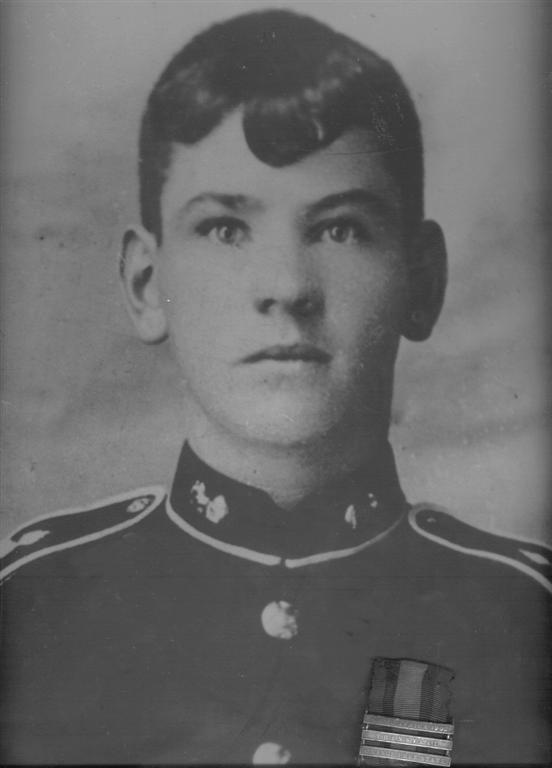
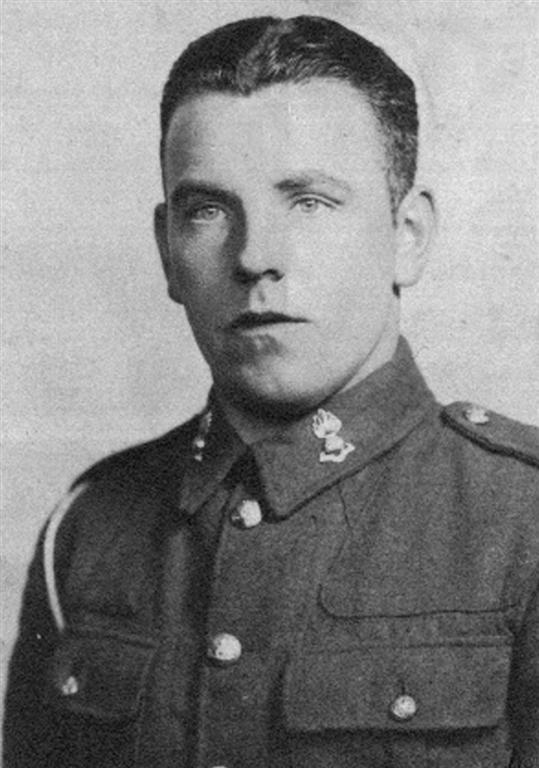
The
Ulster Volunteer Force
Just before WWI an illegal citizens’
militia was raised in 1911. It was used to preserve the
Protestant tradition and population in Ulster.
That militia was called the Ulster Volunteer Force and 300
volunteers were raised in Coleraine to oppose the implementation
of the Home Rule Bill. This Bill was introduced in 1886, 1893 and
then again in 1912. Its aim was to give Ireland a devolved
assembly with limited powers. Protestants opposed the Bill
because they would become a minority in the whole of a Catholic
Ireland.
Bonar Law, the son of a Portrush minister, became the
leader of the Conservative Government in 1911 and championed the
Ulster Protestant cause at that time. By 23 September 1911 there
were thousands of Orangemen parading in Craig’s grounds in Co
Tyrone. This was followed province wide by the Orange Order
providing the halls and facilities to train more volunteers who
were in opposition to the Home Rule Bill.
At that time a law was unearthed that stated two Justices
of the Peace could authorize military exercises in their
jurisdictions in order to provide an efficient citizens’ army
(Stewart, 1966, p69). Licences were duly issued and by January
1913 the Ulster Volunteer Force was 90,000 strong. The south
responded by raising a Catholic army of 190,000 Irish Volunteers.
The Coleraine UVF contingent was under the command of
Major JAWO Torrens. The drill instructors were Willie McGrotty
from Killowen and James Thompson (Mullin, 1979 p26). But with WWI
starting, the implementation of the Home Rule Bill was delayed.
The loyal volunteers joined the 36th (Ulster) Division
and went off to war. Drill Instructor Willie McGrotty from
Killowen was too old for WWI but his sixteen-year-old son, also
called William, forged his age and joined up.
The Irish Volunteers enrolled in the 10th
(Irish) and the 16th (Irish) Divisions.
Partition
The final Home Rule Bill had been
introduced in December 1920 and in December 1921 Ireland was
partitioned into the six counties of Ulster and the twenty-six
counties of the Irish Free State, each with their own
parliaments. Not only did the Irish lose six counties, the
British Army lost six Irish Regiments when they were disbanded.
On 12 June 1922 in St Georges Hall at Windsor Castle King George
V received the twenty Colours of the five infantry Regiments and
the Regimental Engraving of the South Irish Horse. He said,
‘I pledge my word that, within these
ancient and historic walls, your colours will be treasured,
honoured and protected as hallowed memorials of glorious deeds of
brave and loyal Regiments’.
Institutionalised
Discrimination
Institutionalised
discrimination throughout Ireland reached new heights after this
grossly unjust partition. The political structures in both new
states had an inherent sectarian bias. A Protestant Parliment for
a Protestant people and a Catholic Nation for De Valera were the
mutual calls.
The
border became an impassable barrier to the respective governments
wishing to alleviate the suffering of their isolated minorities.
The Irish government tried boycotting goods manufactured in
Belfast to coerce the Northern Ireland government to protect the
northern Catholics who were subject to discrimination and
murderous attacks, particularly in the Belfast area. The boycott
was of little value.
The
Southern Protestant Decline
Between
1922 and the mid 60s the downward spiral of the Protestant
population in the Republic of Ireland accelerated. From the
census in 1911 to the present the overall decline has been 68 per
cent (Hussey, p379).
There have been many reasons suggested for this decline
including an ageing minority, a prolific majority, anxiety,
assassination, mass departure and institutionalised
discrimination. The Central Statistics Office (2000, p55) states
that the Protestant decline can be attributed to the older
generation of the Church of Ireland and the Presbyterians as well
as the high birth rate and low mortality rates of the Roman
Catholics relative to the Protestant minority.
Kenny (2000, p92-93) has discussed how Protestants in the
Republic of Ireland were faced with an uncertain future in those
early years and that may account for them having the lowest rate
of fertility in Europe at that time. The Protestant clergy went
as far as to send a delegation to Michael Collins who reassured
them that the Protestants were welcome in the south. That
reassurance had little value because soon after that Collins paid
the price for signing the documents that divided Ireland with his
own life.
But the problem was initially compounded through
institutionalised discrimination, such as the protocol to be
followed after a mixed marriage. In the old Irish Catholic
tradition all female children were raised in their mother’s
religion and all the male children were raised in the father’s
religion. The Papal decree of Ne Temere was then used from 1908
until 1966. It ensured that when a Protestant married a Roman
Catholic, the Protestant signed a document stating that all their
children would be raised as Roman Catholics.
The Protestant decline in the Republic of Ireland was also
accelerated through exodus. In 1922 the big houses of the
Protestant landowners were being burnt and the working class
Protestants were being shot. For example, in April 1922 twelve
Protestants in Dunmanway, West Cork were picked out and shot in a
single day.
The
Ulster Special Constabulary
The
citizens’ militia had to be raised again in 1920 to counter the
murderous incursions of the IRA from the Republic of Ireland and
the equally murderous activities of the IRA in Northern Ireland.
The government called this citizens’ militia the Ulster Special
Constabulary (USC) and armed them with the 1914 consignment of
Ulster Volunteer Force (UVF) weapons. The Ulster Special
Constabulary was formed as part of the Royal Irish Constabulary
and pre-dated the creation of the state of Northern Ireland.
(Doherty, 2007) As in 1913 when the UVF were training the local
Orange halls throughout the Province were used as training halls
by the USC.
There were three grades of special constable, the A
Specials who were full-time reserve police, the B Specials who
were part part-time police and expected to parade on one or two
nights each week for a four-hour duty. (Howard Gribbon was the
first commander of the B Specials in Coleraine)
The
C Special’s were available for emergency call-out and each man
had to provide his own personal weapon. The A and C Specials were
disbanded in 1926.
WWII
and The Coleraine Garrison
Coleraine
town did not have an army unit garrisoned from 1850 until the
British army raised 6 Light Anti Aircraft Battery, 9th
Anti-Aircraft Regiment Royal Artillery (Supplementary Reserve) on
1 April 1939. The Battery was raised to counter the threat
offered by the German air force, the Luftwaffe. One of the
earliest volunteers was Jim Murray from Maghera who joined in
March 1939. The following month he attended a Bofors gun Anti
Aircraft course at Biggin Hill near London along with Robin
Martin from Coleraine and Stanley McQuigg from Macfin.
When 6 LAA Battery left Coleraine on 28 November 1939 to
take their part in WWII the Calf Lane Camp and the surrounding
towns were used to garrison many of the troops passing through
Coleraine on their way to the European battlefields.
On 26 March 1942, the Coleraine Battery was deployed for
Anti Aircraft defence of the Halfa Railhead in the Western
Desert. They used 20mm Breda guns captured from the Italian Army
for this task. The guns were mounted on three-ton trucks. These
were then loaded on the railway wagons of the train they were
protecting. On 2 April that year, Sergeant Jim Murray was wounded
twice on the left arm by ricocheting bullets as his gun crew shot
down a German Bf109 (Gamble, p73). Jim Murray was wounded again
in 1958 as he defended Swatragh RUC station from an IRA attack.
Photo
9 Railway Anti-Aircraft Protection In the Western Desert 1942
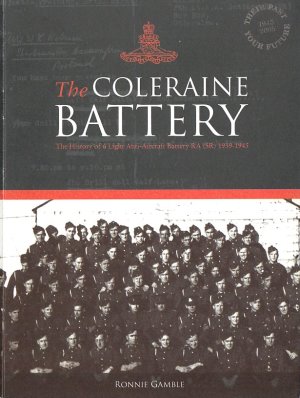
Ulster
Home Guard
Although
the English regular militias were raised again in Great Britain
on 27 May 1940 as the Local Defence Volunteers (LDVs), the 13,000
strong B Specials were expected to carry out the same role as the
LDVs as well as their normal duties in Northern Ireland. But on
29 May a new category of B Specials was created, the Local
Defence category. By 21 June the Local Defence category strength
was 18,742. The final title change took place on 24 August when
they became known as the Ulster Home Guard section of the Ulster
Special Constabulary.
The dress code also went through three phases. Initially
they wore civilian dress with an armband. Next it was black denim
battle dress and finally they were dressed in khaki battle dress
(Hezlet, p141).
“I
joined the Boveedy detachment of the Local Defence Volunteers in
1942. At the start of the war both the Ulster Home Guard and the
B Specials were dressed identically except for the shoulder
flashes or patches. Instead of having a shoulder flash with the
Ulster Home Guard on it the B Specials had a patch on the upper
arm with a B on it.
Many people were in both the Ulster Home Guard and the Bs.
If they were not required for one unit they paraded for the other
unit. There were also A Specials who volunteered from Garvagh and
they were posted out to guard RUC stations in Belfast and other
locations.
The Ulster Home Guard spent most of their time
training for land warfare. We did not become involved in
roadblocks; the Bs did that all the time.
The Ulster Home Guard was eventually stood down in 1944.
The photograph shows the Garvagh Ulster Home Guard Band outside
the Presbyterian Hall in Garvagh. They borrowed the pipes and
drums from Garvagh Pipe Band and marched at the head of the
Coleraine parade for the stand down of the Ulster Home Guard”
S7 & 8.
Photo
10 Garvagh Detachment of the Ulster Home Guard 1944
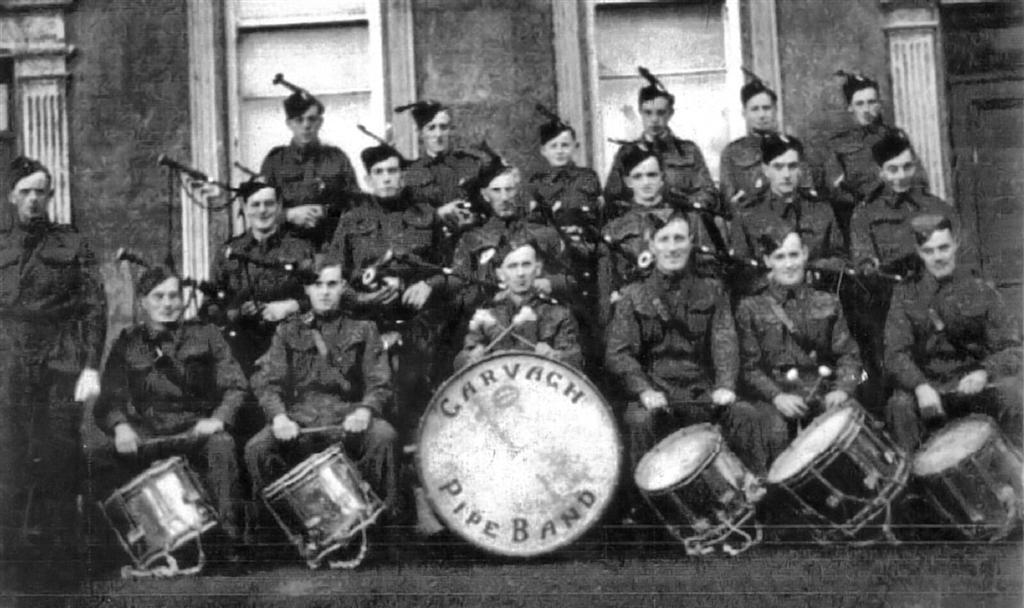
Operation
Harvest
Between
the years 1956 and 1962 the IRA mounted a terrorist campaign
called Operation Harvest. That campaign failed for many reasons.
The main reason was the fact that the Republic of Ireland did not
support the IRA. The Irish Government introduced internment and
used no jury military tribunals to deal with IRA prisoners.
Without political control and direction the military campaign was
undermined and the IRA was unable to galvanise support from the
nationalists community in Northern Ireland.
Many of the IRA s military operations were undermined by a
combination of information supplied to the RUC by a small MI5
unit, co-operation with the Gardi and with the B Specials out on
the ground every night restricting IRA activity. Davy Watton of
Coleraine had served in the Western Desert as a dispatch rider in
the Royal Engineers joined the B Specials on his return to
Coleraine. He was instrumental in the capture of two IRA men who
were preparing a set of plans and sketches of Coleraine Bann
Bridge.
Photo
11 S/Constable Davy Watton
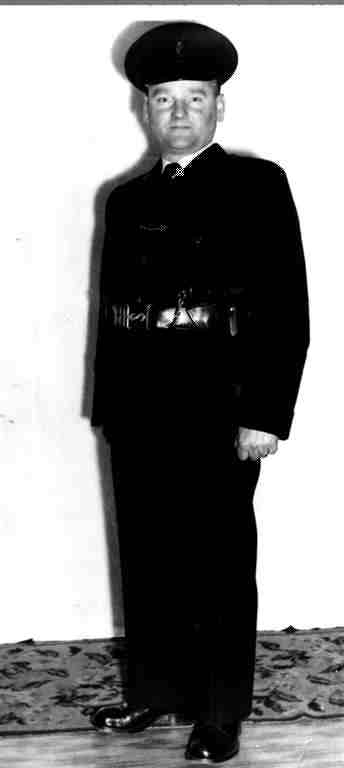
The
B Specials
“I
first joined the Knockloughrim Platoon of B Specials in 1953.
The platoon consisted of three sections. Each section had
a Sergeant in charge and six constables. The Sergeant was
normally promoted to the post because they had prior service in
the armed forces. Our wages were 50p a month or £6 a year.”
S9.
Training
“On
a drill night all you had to do was put your rifle over your
shoulder, get on your bicycle and ride into the local drill hall.
You were relatively safe from attack by Republican gunmen because
while you were on a training night your area was well covered by
other B Special patrols” S7 & 8.
“My
section drilled in Knockloughrim Orange Hall. Frank Pancott and
John Kerr were our Sergeant Instructors. Their job was to travel
around north Derry and train the B Specials on their drill
nights.
On
some training nights we had live firing practice in the hall. We
used the .303 Lee Enfield rifle fitted with a Morris Tube. That
was a sleeve barrel that allowed the rifle to take a .22 round.
On drill nights we always had two men posted outside the
hall with loaded weapons for our security. One man was posted to
each end of the hall. One night Davy Gamble was posted outside on
guard duty. He always carried a Sten Sub Machine gun. After his
stint of guard duty Davy came back into the hall and forgot to
unload the Sten. He dropped the Sten and we all jumped up onto
chairs as the gun started spinning on the ground and firing away
until the magazine was empty. Luckily there were no injuries.
There were shooting competitions nearly every Saturday.
This involved the entire local B Special Platoons. That included
Tobermore, Knockloughrim, Aughagaskin, Bellaghy and Garvagh. The
competitions were held at The Grange, Moneydig or Magherafelt”
S9.
Patrolling
“The
B Specials patrol operated for a four-hour shift. The first shift
was from 8pm to midnight and the second shift ran from midnight
until 4am. The third shift from 4am to 8am was rarely called for.
This four hour evening duty did not have an adverse effect on
your ability to do your normal civilian job the next day.
In the Garvagh area the Bs patrol consisted of a section
of one Sergeant and six men. At the roadblocks there were two
sentries at each end and the Sergeant with his two cover men in
the centre. It was
the Sergeants task to interview anyone stopped by the patrol.
Usually the patrols were transported to each roadblock by
a truck driven by a RUC officer. On other occasions the patrols
were delivered by a couple of the patrol using their own private
vehicles. The vehicles would be concealed and the patrol
conducted in a circular route to bring you back to the vehicles
again.
There were so many Specials out on patrol, it did not
matter where you tried to go, and inevitably you would run into
another Specials patrol. This would happen not once but many
times in the one journey. This was at a time when there were
fewer vehicles on the road, but believe me, you did not travel
far at night without meeting a Specials’ patrol.
The only thing that kept us from stopping traffic was the
fog or icy conditions. That was for safety reasons. The traffic
would be moving slowly in these conditions anyway so we could
identify the vehicle and driver easily” S7 & 8.
Local
Knowledge
“In
the Bs you relied on our local knowledge and prided ourselves on
our grasp of the local knowledge. If you were to take a B Special
to an area outside his local area, he lost that edge.
In
the Garvagh detachment we had a man in our patrol who was lost if
you took him to the end of his own road. One night we totally
befuddled him while we were out on patrol. Sitting in the back of
a covered lorry to be moved around our patrol area could be very
disorientating. When
the patrol was over we had convinced this man that we were
totally lost. We stopped the lorry and told him to get out and
inquire at the nearest house as to where we were. He knocked on
the door and his sister opened it. We had taken him back to his
own home” S7 & 8.
Equipment
“We
were issued with poor quality torches. In the early 1950s these
items were difficult to work with.
All
the time I was involved in the B Specials I did not see any
action personally. There may have been a bit of hassle on the
roadblocks at times but it never amounted to anything serious”
S 9.
The
Swatragh Attack
On
14 January 1958 at 10pm Swatragh RUC station came
under attack from a 70 strong IRA murder gang. These individuals
had chopped down trees to block the eleven approach roads into
Swatragh (Hezlet, p184).
That night the regular RUC in Swatragh had the added
protection of six B Specials from Upperlands. One team of the B
men were posted to the sandbagged position in front of the
station and the remainder were posted to a similar position close
to the Garvagh Road. On hearing distant explosions the road party
moved towards the RUC station and that was when the IRA started
their attack.
S/Constable Jim Murray was the first casualty with an eye
and a leg wound to add to the arm wound he received in the
Western Desert in 1942 (Gamble, 2006). Jim fired his Sten gun
until it jammed and the blood from the eye wound stopped him from
clearing the jam. At that stage S/Sergeant Thomas McCaughey
cleared the gun and with covering fire from the RUC Bren gun in
the upper floor of the station the terrorists were routed (Clark,
p108).
The sound of the gunfight alerted B Specials from the
neighbouring areas who closed in on Swatragh in their private
cars. They detained a well-known IRA suspect at one roadblock. He
had a bullet wound to his chin.
S/Sergeant Thomas McCaughey and S/Constable Jim Murray
were awarded the British Empire Medal for their bravery that
evening.
The photo shows Private Thomas McCaughey, E Company 5 UDR
on the right during a tea break on the Magilligan ranges in 1970.
The soldier in the back of the van is the late Bobby Boyd from
the Quartermaster’s Department based in Battalion Headquarters.
On 18 November 1985 Republican gunmen murdered Bobby
at his front door as he returned home from work. One of his
neighbours was convicted for supplying the information that led
to his murder.
Photo
12 Bobby Boyd and
Thomas McCaughey BEM
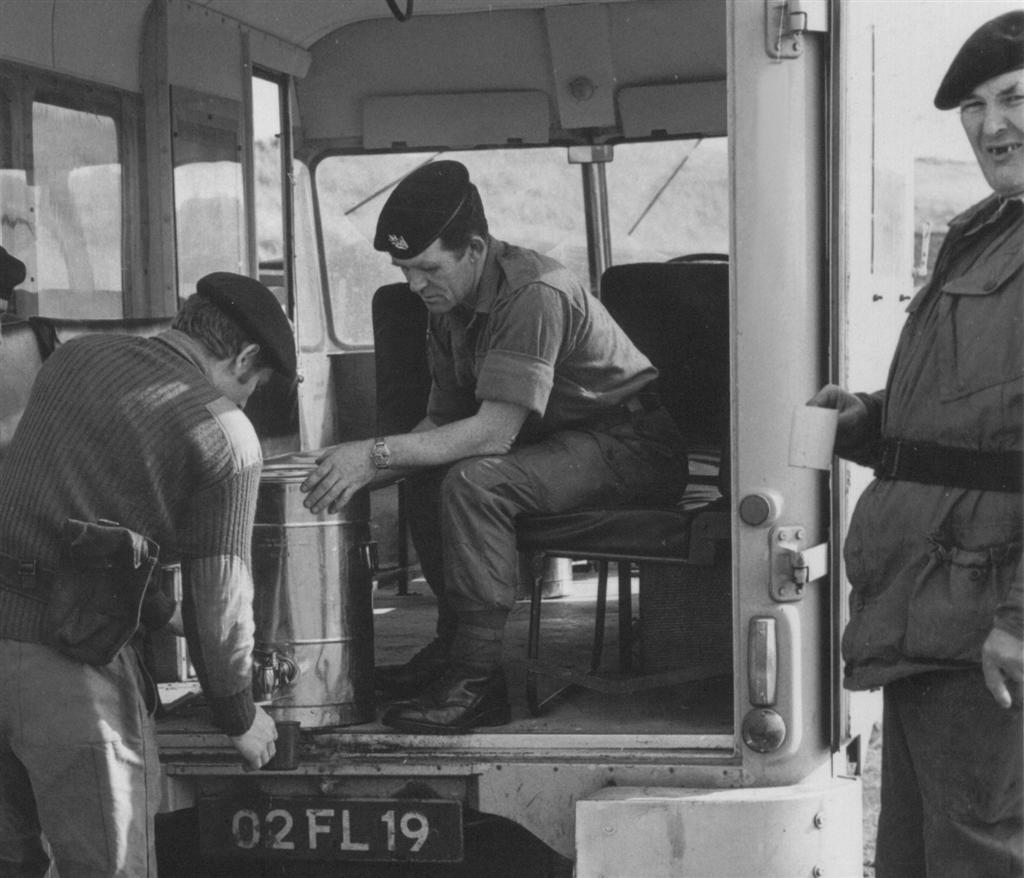
The
Ulster Defence Regiment vs. The B Specials
“When
you compare the achievements of the B Specials and the UDR I
believe the Bs were a more effective force in dealing with the
IRA. Because we operated in our own hometown, we knew everyone we
met and recognised his or her vehicle before it reached our
patrol. With the same token it was easy to identify strangers.
The UDR patrols were better equipped to deal with the
terrorist threat. For example, they had great radio
communications and night viewing aids.
Because the UDR units were more centralised there was more
time lost in preparing for patrols. The amount of time lost in
many operations was 25 per cent of the time available. For
example, the soldier had to report to a base depot in order to
draw his weapon, be briefed and then transported to the task
area. Then there was time lost on the return journey to stand
down.
In the Bs you were on fifteen minutes notice to grab your
rifle and make it to the designated point for the patrol.
Everything you needed for the patrol was in your own home.
The
general public had a better regard for the B Specials. Many
people regarded the B Specials as ruthless. The fact was that the
B Specials either stopped or deterred many terrorist actions. We
also stopped a lot of other criminal activity around the province
by being on the ground all the time.
At one time we had permission to shoot at any vehicle that
went through our roadblock without stopping. The threat was
always there and the general public did not take a chance on
running from a B Special patrol.
The UDR were issued with superior weapon systems but by
the time legislation had introduced Green, Yellow and Blue cards
you might as well have left your weapons in the armoury for all
the use or threat they presented to the terrorist” S 9.
The
B Special Criticism Answered
The
B Specials were neither equipped nor trained to deal with the
modern terrorist and the sophisticated equipment they used. By
1976 all the criticisms directed at the UDR by some B Specials
became history. The UDR were now on the ground every hour of the
day conducting large-scale patrol operations with the equipment
and training necessary to cope with the modern terrorist.
Previous Chapter 4 - Coleraine Garrison and the Rebellions Next Chapter 6 - The First Officer Commanding E Company